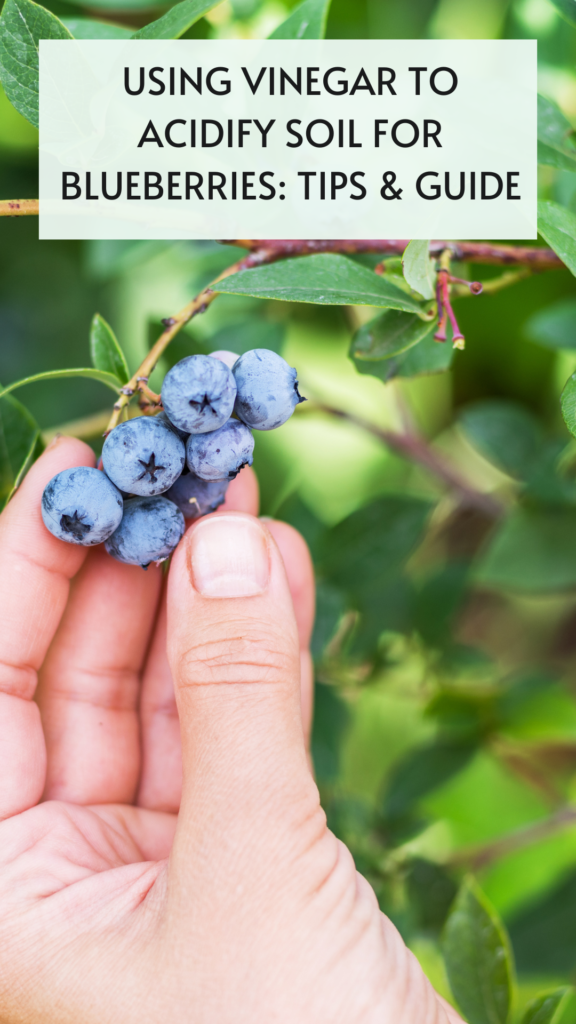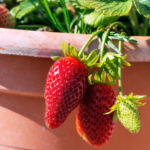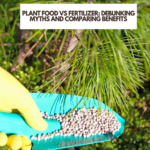Are you wondering if using vinegar to acidify soil for blueberries is a good idea? Well, we will review this method in this blog post.
Growing blueberries can be a rewarding experience for gardeners, as these antioxidant-rich fruits are not only delicious in taste but also add a pleasant aesthetic to any garden. However, blueberries require specific soil conditions to thrive, with an optimal pH range between 4.5 and 5.5.
Ensuring that the soil is adequately acidified is crucial for blueberry plants to receive essential nutrients and grow to their full potential. One inexpensive and eco-friendly solution for acidifying soil is the use of vinegar.
FTC DISCLOSURE: Some of the links in this post are affiliate links. If you click on them and make a purchase, I will receive a small finder’s fee on the sale. This does not increase your price in any way shape or form. Using these links help support the continuation of this website. All opinions are my own. Thank you in advance.
Using vinegar for blueberry bushes, when diluted with water, can be highly effective in lowering soil pH levels to create a suitable environment for blueberries.
It contains acetic acid, which works to release hydrogen ions and displace other positively charged ions, consequently increasing soil acidity. This method is particularly beneficial for those who prefer a more organic and less chemically invasive approach to gardening.
To successfully acidify soil with vinegar, it is essential to understand the appropriate dilution ratios, application methods, and safety precautions involved. Monitoring the soil pH levels before and after applying the vinegar solution will help gardeners achieve the right acidity balance and optimize blueberry plant growth.
Understanding Soil Needs for Blueberries
Blueberry Plant Requirements
Blueberries are acid-loving plants that thrive in a specific range of soil conditions. They prefer a well-drained, loamy soil rich in organic matter like sphagnum peat. Ensuring the right soil environment is crucial for a healthy, productive blueberry plant.
Soil pH Levels
The pH level is a measure of the acidity or alkalinity of soil. Blueberries require an acidic soil environment with a pH level between 4.5 and 5.5. This is different from most plants, which typically favor a slightly acidic to neutral pH level between 6.0 and 7.0.
Acidic Soil
To create an acidic environment for blueberries, gardeners can amend their soil with certain materials. Two common soil amendments for acidifying soil are sphagnum peat and elemental sulfur:
- Sphagnum peat: This material, rich in organic matter, can lower soil pH when mixed into the soil. To incorporate peat moss into soil, mix it in a 1:1 ratio with the existing soil, creating a well-blended mixture.
- Elemental sulfur: Elemental sulfur is another effective amendment for decreasing soil pH. To use elemental sulfur, follow the manufacturer’s recommended application rate, generally based on the desired pH level and the sulfur’s granular size.
Iron Deficiency
Iron deficiency is a common issue in blueberry plants grown in soil with improper pH levels. To ensure that blueberries grow well, it’s essential to maintain a consistently acidic environment. When blueberries are grown in soil with a pH level higher than their preference, they may struggle to absorb iron and other nutrients, leading to poor growth and lower yields.
It’s crucial for gardeners to test the soil before planting blueberries, as well as periodically monitor soil pH levels. This can be done using a soil sample and a soil test. When necessary, amend the soil to maintain the optimal pH range for blueberries. By understanding and meeting blueberries’ specific soil requirements, gardeners can support the growth and productivity of these acid-loving plants.
Using Vinegar to Acidify Soil
How Vinegar Lowers Soil pH
Vinegar contains acetic acid, which can effectively lower soil pH levels. When applied to the soil, acetic acid aids in lysing bacteria, releasing hydrogen ions. These ions then react with minerals in the soil, ultimately increasing acidity and lowering the soil’s pH. Blueberries thrive in acidic soil, and utilizing vinegar is a natural method to help them flourish.
White Vinegar versus Apple Cider Vinegar
There are various types of vinegar, but white vinegar and apple cider vinegar are most commonly used for acidifying soil. Both types work effectively, but the key difference lies in their concentration of acetic acid.
- White vinegar: Typically contains 4-7% acetic acid, making it a more potent option for lowering soil pH.
- Apple cider vinegar: Contains around 5% acetic acid, which can also be effective in lowering soil pH but may require a larger quantity compared to white vinegar.
Applying Diluted Vinegar to Soil
To use vinegar for acidifying soil, it must be properly diluted with water. A general rule of thumb is to mix 1 cup of vinegar with 1 gallon of water. This solution can then be applied to the soil around the blueberry plants. Monitor the soil pH levels closely and repeat the process as needed to maintain optimal acidity conditions for blueberry growth.
Limitations and Risks of Using Vinegar
While vinegar can effectively lower soil pH, it’s important to be aware of the limitations and risks associated with its use:
- Effect duration: Vinegar is a temporary solution, as soil pH levels may naturally rise again over time. Regular monitoring and reapplication are necessary for maintaining optimal conditions.
- Over-acidification: Be cautious not to over-apply vinegar, as excessive acidity may damage plant roots or decrease nutrient availability in the soil.
- Ecological impact: Using excessive amounts of vinegar can harm beneficial soil organisms, affecting the overall health of the soil ecosystem.
In summary, vinegar can be a helpful tool in acidifying soil for blueberry growth. Users should be aware of the proper application methods and potential risks to avoid adverse effects on the plants and soil ecosystem.
Alternative Methods to Acidify Soil
Using Sulfur to Lower Soil pH
One effective way to acidify soil for blueberries is by using sulfur. Sulfur can be applied to the soil in two primary forms: elemental sulfur and sulfur-containing compounds like ammonium sulfate and aluminum sulfate. Elemental sulfur is the most cost-effective method, available in the form of sulfur granules. It gradually lowers the soil pH when naturally occurring bacteria in the soil convert the sulfur to sulfuric acid.
Sulfur works best in sandy soil, as it takes more time to react with clay soil. The quantity of sulfur required depends on the soil type, initial pH, and the desired pH level. It is essential to follow the manufacturer’s recommendations and conduct regular soil tests to monitor the progress.
Amending Soil with Peat Moss and Pine Needles
Another common method to acidify soil is by incorporating peat moss and pine needles into the soil. These materials are rich in organic matter and help lower the soil pH as they decompose.
A layer of peat moss can be mixed into the top few inches of the soil, and pine needles can be used as mulch around the blueberry plants. Be aware that these amendments may take a while to impact soil pH significantly, but they provide additional benefits like improved water retention and increased beneficial microorganisms.
Choosing Acidic Fertilizers
Selecting the right fertilizer is crucial for successful blueberry growth. Some acidic fertilizers, such as ammonium sulfate and aluminum sulfate, can effectively lower soil pH. However, these chemical fertilizers can lead to aluminum toxicity if overused. A more natural option is using coffee grounds or compost, which are slightly acidic and can help maintain the desired pH levels while providing essential nutrients to the plants.
Acid-Loving Bacteria and Organic Amendments
Incorporating acid-loving bacteria and other organic amendments into the soil can also help achieve the ideal pH for blueberries. These microorganisms release acids as they decompose organic matter, which can help acidify the soil. Some examples of organic amendments that encourage acid-loving bacteria include compost, aged manure, and sawdust.
Organic gardening is an excellent approach for blueberries, as it not only helps in acidifying the soil but also promotes a healthy soil ecosystem. Regularly incorporating organic matter into the soil can ensure long-term success in growing blueberries.
Blueberry Care and Maintenance
Irrigation and Watering
Blueberry plants require consistent moisture levels to thrive and produce a healthy crop. Gardeners should establish a reliable irrigation system to ensure the plants’ roots receive sufficient water. A drip line system is ideal, as it provides a steady supply of moisture directly to the roots without oversaturating the surrounding soil. Blueberry bushes may need additional watering during dry spells or prolonged heat, so it’s crucial to monitor soil moisture levels.
Proper Fertilization
Nutrients, especially nitrogen, play a significant role in blueberry bush growth and fruit production. Fertilization should be approached with care, as too much nitrogen can lead to stunted growth. Gardeners should opt for a slow-release, balanced fertilizer specifically formulated for blueberries. It is recommended to apply fertilizer in early spring and again in late summer, following package directions for proper application rates.
Optimizing Soil Conditions
For blueberry plants to thrive, soil acidic conditions are essential. The plants prefer a pH level between 4.5 and 5.5, ensuring that the roots can access the necessary nutrients. Gardeners can use vinegar to acidify the soil if pH levels are higher than desired. However, it is essential to apply vinegar in moderation to avoid creating extremely acidic conditions that could harm the blueberry plants. Another option is incorporating soil amendments such as peat moss or pine bark to lower pH levels.
To acidify soil with vinegar:
- Mix 1 cup of white vinegar with 1 gallon of water
- Apply the solution around the base of the blueberry plants
- Monitor pH levels and adjust the vinegar ratio as necessary
Regular Soil Testing
Routine soil testing is a crucial aspect of blueberry care and maintenance. Blueberry plants rely heavily on a particular pH range, and if the soil strays from the desired pH level, the plants may experience nutrient deficiencies or struggle to grow. Gardeners should test soil pH levels at least once per year, preferably in late fall or early winter after the growing season has ended. Soil testing clarifies the existing nutrient concentrations and pH levels, allowing adjustments to be made for optimal growing conditions.
In conclusion, blueberry care and maintenance should include procedures such as irrigation and watering, proper fertilization, optimizing soil conditions, and regular soil testing. By carefully monitoring these factors, gardeners can promote a flourishing environment for their blueberry bushes and enjoy a healthy, bountiful crop.
Preparing Your Blueberry Patch
Determining Soil Conditions
To grow a bountiful crop of blueberries, it’s crucial to begin by determining the soil conditions in your blueberry patch. Blueberries thrive in well-drained soil with a pH level between 4.5 and 5.5. Purchase a soil pH tester kit from your local gardening center or online to determine the pH level of your patch. If the pH is higher than desired, you will need to acidify the soil to promote the growth of a strong primary root system.
Choosing the Right Fertilizers and Amendments
Lowering the soil’s pH is essential for healthy blueberry plants. Use high-acid fertilizers, such as urea and ammonium sulfate, or organic fertilizer alternatives like cottonseed meal, elemental sulfur, or manure from animals raised on high-clover. Be cautious when using sawdust, as it can have inconsistent acidifying properties and may not be a long-term solution.
In addition to fertilizers, consider amending the soil with materials commonly used to acidify soil for other acid-loving plants like azaleas. Peat moss, pine needles, and oak leaf mulch are effective amendments that can gradually lower the pH.
Recommended fertilizer amounts:
| Fertilizer | Amount per 100 sq. ft. |
|---|---|
| Urea | 0.25 – 0.5 lbs. |
| Ammonium Sulfate | 0.75 – 1.5 lbs. |
| Cottonseed Meal | 4 – 8 lbs. |
| Elemental Sulfur | 0.5 – 2 lbs. |
| High-Clover Manure | 30 – 60 lbs. |
Proper Planting Techniques
Proper planting techniques are vital for a successful blueberry patch. Before planting, remove all weeds and grass from the planting area and rototill or spade the soil to a depth of 8-12 inches. Plant blueberry plants in early spring or fall when the weather is mild.
The hole should be slightly larger than the root ball, ensuring that the primary root system has room to grow properly. Place the plant in the hole so that it sits at the same depth as it was in the nursery container, then gently backfill the hole with acidified soil. Finally, water the plant thoroughly to settle the soil around the roots and support the establishment of your tiny blueberry patch.












